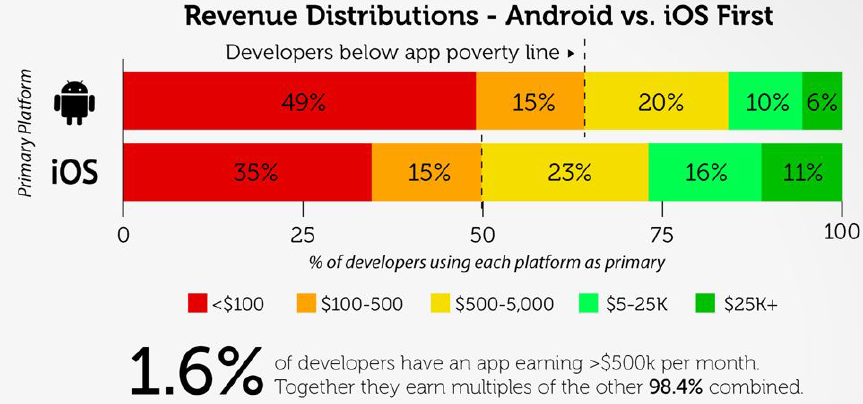Lessons From the Consumer App Gold Rush: How Enterprise Mobile App Developers Can Succeed
Tuesday, December 16, 2014

|
David Lavenda |
Developers continue flocking to mobile applications, and for good reason; according to investment bank Digi-Capital, mobile app revenues could reach $70 billion by 2017. On the other hand, most of these developers are struggling and need to accept that the consumer app Gold Rush is over. Some apps continue to defy reason and explode seemingly overnight (think Flappy Bird and Yo), but all of the analysis in the world has proven futile for new developers trying to systematically replicate that success – to the tune of 47 percent of app developers making $100 or less in any given month.

Source: Developer Economics: State of the Developer Nation Q3 2014, VisionMobile
The good news is forward-thinking developers can take advantage of a new Gold Rush; a VisionMobile survey of 10,000 app developers found that only 16 percent of them target the enterprise today. Those that do are twice as likely to earn over $5,000 per app per month and almost three times as likely to earn more than $25,000 per app per month, leaving a major untapped opportunity in the mobile enterprise.
To take advantage of this growing opportunity and avoid the mistakes of the consumer app Gold Rush, developers must understand new enterprise customer needs, existing consumer expectations for app usability and the mobile maturity level of enterprise practitioners.
New Enterprise Market, Same Fragmentation Problem
Mobile devices don’t allow for multitasking in the same way desktops do, so each app serves a very specific purpose. While consumers can make do with focusing on one task at a time, the pace of the workplace today necessitates both speed and multitasking. The philosophy for enterprise app development to date has focused only on the speed aspect, empowering users to complete whatever activity the app is designed for in less than a minute
As enterprise mobility expands to become a central part of more business systems and daily use cases, the single-use app phenomenon is leading to a glut of fragmented solutions, with providers like SAP offering over 60 individual targeted apps. While this works for simple tasks like expense reporting or travel requests, it does not work for business processes like customer service. For these cases, less is more; one app that focuses on the entire business process rather than on a discrete task.
Know Your Customers’ Needs
The challenges of a fragmented mobile experience don’t mean that a single-use approach is always wrong. When developing a mobile app, complete an evaluation up front to determine what need you’re solving for. Ask yourself: “is the functionality I’m providing easy to offer in an atomic app? Or is it part of a larger business process that needs to be integrated into a single flow?” Then develop your app accordingly.
The single-use approach is well understood, but the process-oriented approach for app building is not. When your end-user needs to see a larger business picture, you need to consider two things before building your app: 1) other potential systems the business user interacts with; and 2) the functionality vs. ease of use of your app.
Cloud Solution Silos
Business processes often require information from additional sources that your app can’t easily access on the back-end, meaning you need to work on plugging into these cloud services to reveal the big picture for business users. Unfortunately clouds systems don’t interoperate, so until the industry sees standards that make cross-cloud communication easier, weaving information from different systems into your app will remain a difficult (but necessary) process. Before writing any code, researching which systems your end users need visibility into is crucial to avoid wasting resources integrating into unnecessary systems. In the future, monitor for solutions that have open standards and enable easy integration.
Ease of use vs. functionality
The more functionality and information you integrate into your app, the more important intelligent filtering becomes to help the user map data to business processes rather than atomic task management. For the filtering component, consider how to present the right information at the right time and what types of filter mechanisms are available for this. Context is a powerful tool to leverage for filtering information, and the world of context is growing more sophisticated all the time with location, time, calendar information and more becoming increasingly accessible.
You should also be aware that the more functionality you include, the more difficult the app becomes for your users to understand. Salesforce, for example, has a mobile app that started out as a single-use tool to look up contacts, but as its users’ needs evolved, it has shifted towards including complex capabilities to mimic the web experience. These new features led to a trade off, where the more functionality and the richer the experience, the more complicated things have become given the limited screen real estate of mobile devices. Make sure to balance your users total needs (both functionality-based and information-based), and then add the exact features and data sources they need to function within the context of their business process.
Creating Apps for Your Audience: Mobile Enterprise Maturity Level
While the market holds enormous promise, the mobile enterprise space is still largely immature. Mobile devices today are limited in their use cases and the culture surrounding them, and even simple tasks like email are not yet accessible for 20 percent of business users in the mobile enterprise.

Source: The State of Mobile Enterprise Collaboration 2014, harmon.ie
In a recent harmon.ie survey of 1,400 business and IT leaders, only about a third of respondents indicated access to mobile collaboration tools, and just seven percent of business respondents considered their companies “innovators” of mobile collaboration. The possibilities for enterprise mobility are impressive (including new free Microsoft Office apps, fully-featured mobile CRM and ERP systems, etc.), but the reality is that less than half of business users are even aware of a mobile device policy at their company today, and most of these tools remain unused.
The good news is that if you’re just getting started with mobile enterprise app development, the monetary potential is there and you’re arriving at the party just in time. However, the early stage of mobile enterprise maturity also means you need to take people’s expectations into account based on their consumer experience, and balance the single-use experience consumers are used to with more complex productivity needs in the enterprise. The old SAP experience won’t transfer over to the enterprise world, but neither will the consumerized Facebook method of breaking one desktop offering into six or more mobile apps per platform. Successful mobile app developers will create the perfectly balanced app, and use intelligently integrated information and context to present the right information at the right time to business users.
Have you started developing mobile apps for the enterprise? If so, what have been your biggest challenges and opportunities to date? Let me know in the comments or connect with me on twitter at @dlavenda.
Read more: http://harmon.ie
This content is made possible by a guest author, or sponsor; it is not written by and does not necessarily reflect the views of App Developer Magazine's editorial staff.

Become a subscriber of App Developer Magazine for just $5.99 a month and take advantage of all these perks.
MEMBERS GET ACCESS TO
- - Exclusive content from leaders in the industry
- - Q&A articles from industry leaders
- - Tips and tricks from the most successful developers weekly
- - Monthly issues, including all 90+ back-issues since 2012
- - Event discounts and early-bird signups
- - Gain insight from top achievers in the app store
- - Learn what tools to use, what SDK's to use, and more
Subscribe here




_cptybzmh.jpg)








